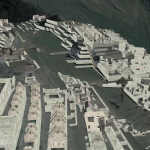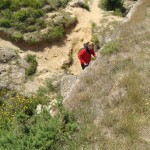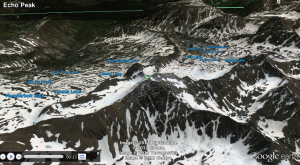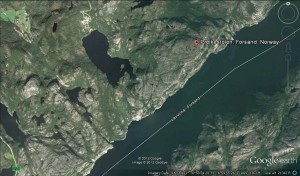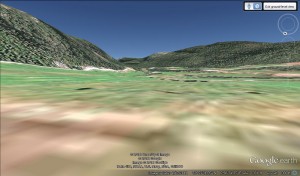Fair Hill Nature Center was had always seemed a world apart; when you crossed the road bordering my warren-like, wooded neighborhood and then ducked the brush that lined the other side, like ducking coats in the wardrobe, and emerged into vibrant, open space. From that entrance out of the brush you stood along a well-trod dirt path that wound through an enormous field that rose and fell gently. Going left on the path sent you into woods filled with switchbacks and a trail that snaked up and down a series of hills. The one time my friends and I attempted it while out running, we emerged from the other side of the woods at a fork in the road uncertain which trail to take and chose the center, which turned out not to be an actual trail at all but a deer path. We ended up running through the woods on the narrow side of a cliff, breathlessly tripping over roots, none of us daring to stop.
But going right on that first was the course I was far more familiar with. I loved it best in fall, when running after school would set the light just right against the trees, the leaves ablaze with their new colors. I loved it too when a storm threatened and the sky crowded in gray and close, making details sharper, more cinematic. The trail cut a swath through long grasses, and at the end of the field cut through a brief patch of woods, the path becoming steep and gravelly. On the other side of the woods the path skirted around the bottom of another field before coming to a small creek that you have to hop rocks to cross. After another stretch of woods, another field, and then woods, there was a big uphill path through a final field before you reached a bridge over the road that bisected the nature center. That was usually the point at which we turned back and went home.
The entire area was always teeming with life: birds calling, tadpoles sitting in pools beside the trails, and, if we ran close enough to dusk, deer grazing and foxes slipping through the trees. Looking at Fair Hill through Google Earth, however, was an absolutely lifeless experience. The land was nearly flat, the colors muted, and all the rich detail was pressed out of the environment. The place I love so much for its uniqueness looks exactly the same as any old stretch of fields from Google Earth. I traveled the entire length of my usual path, but there wasn’t much to see. Even the bird’s-eye view lacked detail, although I was pleased that I could make out the trail itself.

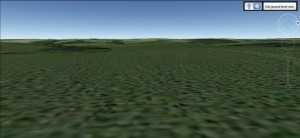


 I went to the base of a mountain. To my tired eyes, it seemed more like a giant mound of dirt. I could see paintings on the side of it. It was probably drawn with some sort of clay many years ago. It looks a lot like a tribe of Native Americans out hunting. Whatever this masterpiece portrays, I hope that it will remain there in History for other travelers to marvel at. I finally waited a few hours for the sun to go down some before attempting to scale the mountain. There is no way I want to be any closer to the mid day sun than I have to. I reached the top in time to see the sun retreat back under mountains and mesas to the West. The sky was filled with dazzling hues of pink and orange. It was calm and serene like a bouquet of flowers. As I reached the bottom of the mountain, I was met with another surprise. What lie only a few yards ahead of my appeared to be an abandoned town. I ventured closer. I dusted off the sign to one of the buildings to see “Hyder Sheriff’s Department” written in bold red letters.
I went to the base of a mountain. To my tired eyes, it seemed more like a giant mound of dirt. I could see paintings on the side of it. It was probably drawn with some sort of clay many years ago. It looks a lot like a tribe of Native Americans out hunting. Whatever this masterpiece portrays, I hope that it will remain there in History for other travelers to marvel at. I finally waited a few hours for the sun to go down some before attempting to scale the mountain. There is no way I want to be any closer to the mid day sun than I have to. I reached the top in time to see the sun retreat back under mountains and mesas to the West. The sky was filled with dazzling hues of pink and orange. It was calm and serene like a bouquet of flowers. As I reached the bottom of the mountain, I was met with another surprise. What lie only a few yards ahead of my appeared to be an abandoned town. I ventured closer. I dusted off the sign to one of the buildings to see “Hyder Sheriff’s Department” written in bold red letters. I was right on the city line for Hyder, Arizona. This is one of America’s ghost towns that was very prosperous in the Old West. The sun was almost set and I could already feel my nerves become tense. The howling wind was nowhere as terrifying as the howling coyote I heard over the mountain I had just trekked. If I ever want to tell others about my discovery of this ghost town, I must make it back home before I become a permanent resident of this place.
I was right on the city line for Hyder, Arizona. This is one of America’s ghost towns that was very prosperous in the Old West. The sun was almost set and I could already feel my nerves become tense. The howling wind was nowhere as terrifying as the howling coyote I heard over the mountain I had just trekked. If I ever want to tell others about my discovery of this ghost town, I must make it back home before I become a permanent resident of this place.
